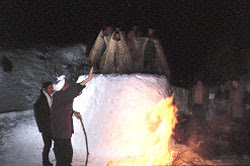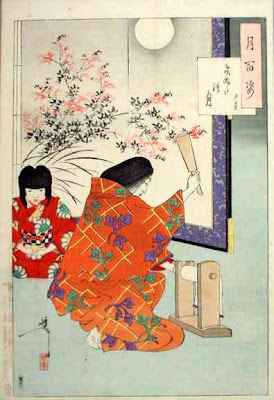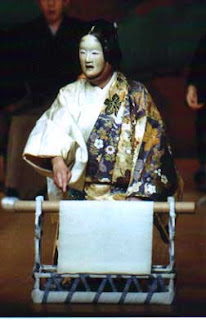- - - - - for Egawa Tarozaemon, see below
::::::::::::::::::::::::::::::::::::::::::::::::::::::::::::::::::::::::::::::::::::::::::::::::::::
Garlic chives, Chinese chives (nira)
***** Location: Japan
***** Season: Various, see below
***** Category: Plant
*****************************
Explanation

chives, nira 韮 (にら), kamira かみら (加美良)、
mira みら (弥良)、"two letters" futamoji ふたもじ
Allium tuberosum, Garlic chives
kigo for mid-spring
often translated as LEEK, but that is a different plant.
In the Japanese saijiki, Garlic comes next after nira chives.
Allium tuberosum LINKS
The Japanese name of "futamoji" goes way back to the Heian period. The aristocracy wrote the name of the leek 葱 like this “ギ”(one letter). The more complex character for the chives, 韮 was then called "two letters".
KAMIRA 加美良(かみら) dates back to the historical chronicles of the Kojiki.
KUKUMIRA 久々美良(くくみら) is an old reading of the poetry collection Manyo-Shu.
The M from the older reading of MIRA later changed to an N.
:::::::::::::::::::::::::::::::::::::::::::::::::::::::::::::::::::::::::::::::::::::::::::::::::::::

flowers of the chives, nira no hana
韮の花 (にらのはな)
ninniku no hana 蒜の花 (にんにくのはな) garlic flowers
kigo for late summer
nobiru no hana 野蒜の花 (のびるのはな) Nobiru flowers
kigo for early summer
There is also a kind of yellow garlic chives, 黄ニラ.
This is a speciality of Okayama prefecture.
. . . CLICK here for Photos !
Yellow garlic chives for the Momotaro pot Okayama
::::::::::::::::::::::::::::::::::::::::::::::::::::::::::::::::::::::::::::::::::::::::::::::::::::
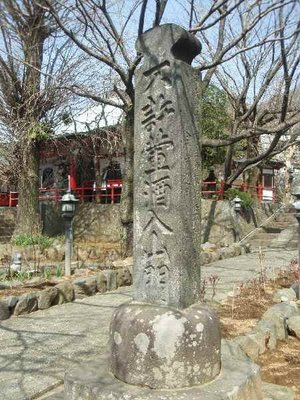
不許葷酒入山門
くんしゅさんもんはいるべからず
kunshuu sanmon hairu bekarazu
葷酒山門に入るを許さず
kunshuu sanmon ni iru o yurusazu
Garlic chives and liquor are not allowed
into the monastery.
葷 KUN refers to garlic chives and garlic.
These words are engraved in stone beside the entrance of a Buddhist monastery. This stone is also called kekkai seki 結界石(けっかいせき) "stone that separates the normal world from the Buddhist world".
Some temples called the hot ricewine
"hot water of wisdom" hannyatoo 「般若湯(はんにゃとう)」
or "water of wisdom" chie no mizu 「智慧の水」.
葷酒山門にいるを許さず紅葉哉
kunshu sanmon ni iru o yurusazu momiji kana
no garlic and wine
beyond the temple gate ...
red autumn leaves
Terada Torahiko 寺田寅彦 (November 28, 1878 - December 31, 1935)
source : jofuan/myhaiku
Daruma Museum
More about 葷酒山門 kunshu sanmon
Temple Gate, no garlic or liquor beyond this point!
:::::::::::::::::::::::::::::::::::::::::::::::::::::::::::::::::::::::::::::::::::::::::::::::::::::
Nira chives are a favorite ingredient in Chinese food. Here in Japan, it comes in miso soup, on scrambled eggs or in gyosa dumplings and many other preparations.

japanesefood.about.com: Nira (chives)
*****************************
Worldwide use
*****************************
Things found on the way
"Chives Mountain", Nirayama 韮山, is a town in Izu peninsula.
During the Edo period, the famous reformer Egawa Tarozaemon
江川太郎左衛門 (1801-1855) lived here.

A scholar of warfare and a civil administrator. As his family members had been for generations, Tarozaemon was the successive governor of Izunokuni Nirayama. Tarozaemon was familiar with the conditions of the people from the time he was appointed governor of Izunokuni Nirayama. He was an honest worker who listened to the views of the agricultural policy administrator and thinker, Sontoku Ninomiya, and was called “Edo’s God of Social Reform.”
After becoming conscious of naval defenses, he learned artillery from Kazan Watanabe and Western artillery from Shuhan Takashima and served as a professor of artillery. Tarozaemon got on the wrong side of Yozo Torii, the Edo Magistrate who disliked Western studies, and nearly fell from power in the bribery case of Bansha, but he was rescued by Tadakuni Mizuno, was later promoted by the top leaders of the shogunate government, and built six gun batteries. He devoted himself throughout his life to naval defense, building foundries and air furnaces in Nirayama and producing canons and guns. He is also known as Hidetatsu Egawa.
Torazaemon baked hardtack as ready-to-eat food for soldiers following the method taught by a student of Shuhan Takashima, and the Japan Bread Association called him the “Father of Bread” of Japan.
© 2006 MINATO CITY. Tarozaemon Egawa
pan no hi パンの日 day of bread - April 12
When the first bread was baked in the home of Egawa family 太郎左衛門 near Nirayama, Izu 韮山, in 1840.
It was very hard and durable, as food provisions for the soldiers, and called
hyooroo pan 兵糧パン.
It was baked in oil in a huge iron pan in the main kitchen of the large Egawa estate. The Egawa family is now in the 42th generation.
The Chinese Opium War has just started and Japan was afraid foreighn soldiers might come to Japan too. So the nation prepared for war.
The Egawa family also build small cannons to defend their harbour in Izu.
More in the WIKIPEDIA !
His soldiers used a special kind of light helmet called the "Nirayama Helmets, nirayama gasa 韮山笠".
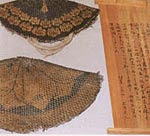
They were like circles, folded in half, made from leather or twisted paper strings (koyori 紙縒り). The paper was then covered with laquer or sometimes light leather. Some troups of the Bakufu government, especially soldiers from Aizu, Nagaoka and Shonai, used these helmets.
They were not produced in large numbers and not many remain to our day.

© PHOTO : www.wbr.co.jp
Japanese Reference
韮山笠でっす
Egawachoo 江川町 Egawa Cho District
Chiyoda ward, Higashi Kanda 東神田一丁目
This district was founded in 1706 and is rather small. It was named after Egawa Tarozaemon, who lived here.
The Egawa clan came from Nirayama, Izu.
. Place names of Edo .
:::::::::::::::::::::::::::::::::::::::::::::::::::::::::::::::::::::::::::::::::::::::::::::::::::::::
- quote
Ninomiya Sontoku 二宮尊徳
(September 4, 1787 – November 17, 1856), born Ninomiya Kinjirō (二宮 金次郎) Kinjiro, was a prominent 19th-century Japanese agricultural leader, philosopher, moralist and economist.
. . . Though he did not leave written philosophical work, his idea were later transcribed by his disciples, namely Tomita Takayoshi, Fukuzumi Masae and Saitō Takayuki. Ninomiya combined three strands of traditional teachings Buddhism, Shintōism and Confucianism and transformed them into practical ethical principles which matured out of his experiences. He saw agriculture as the highest form of humanity because it was the cultivation of resources given by the Kami.
Ninomiya Sontoku emphasized the importance of compound interest which was not well understood among samurai and peasants. He calculated the maturity of each interest rate for 100 years to show its significance by using the Japanese abacus or soroban. In terms of agriculture, he viewed agricultural village life as communal, where surpluses from one year were invested to develop further land or saved for worse years, and shared by members of the community. He was aware that developed land had a lower tax base than established agricultural land and he was adept at financial management which he applied to his estate. He also encouraged immigrants from other estates and rewarded them if they successfully established an agricultural household.
He started his own financial institutions called gojoukou - gojookoo (五常講 ごじょうこう), which appear to be a forerunner of credit union. Each member of the village union could borrow funds interest free for 100 days, while the entire membership shared the cost in case of default. Combination of land development, immigration and communal finance all managed under diligent utilisation of abacus was a success and became the standard methodology of economic development in feudal Japan.

It is not uncommon to see statues of Ninomiya in or in front of Japanese schools, especially elementary schools. Typically these statues show him as a boy reading a book while walking and carrying firewood on his back. These statues are depicting popular stories that said Ninomiya was reading and studying during every moment he could.
© More in the WIKIPEDIA !
- His statue at temple
. Buppoo-Ji 仏法寺Buppo-Ji .
Mimasaka, Okayama 美作市川北

source : www.naritasan.or.jp
He practised danjiki shugyoo 断食修行 fasting at temple Narita san in Chiba for 21 days and then went on to help the farmers in need.
- quote
Ninomiya s plans had been fairly successful, but
the work was very slow. Feeling somewhat
discouraged, he decided to appeal to Heaven for
help. Some hold that Ninomiya was sincere in
this action, and that he really felt his dependence
upon some power higher than himself ; others held
that his action was purely spectacular, that he
wished to win the people by an appeal to their
religious and superstitious nature. But whatever
his motive may have been, he went to the Buddhist
temple at Narita to pray for the success of his work.
He secured lodging at the inn, and was daily in
the attitude of worship before the god, fasting and
bathing in cold water. He made several short
prayers, and some definite vows before the god.
He prayed that calamity, including death, disease,
accident, and debt, might be replaced by blessing,
prosperity, and happiness. He prayed that
deserted wastes and barren soil might give
place to well-cultivated plains and rich,
productive farm lands; that poverty, tribulation, and
hardness might be replaced by wealth and joy, and
by all that was for the good of the people. He
vowed that he would renounce everything that was
detrimental to human development, and that he
would endeavor to give them everything that would
tend to make their lives truly blessed.
He continued thus for twenty-one days. The priest
afterward said that he admired Ninomiya s un
selfish spirit. Instead of praying for his own selfish
benefit, as others did, he prayed for the people.
Ninomiya had gone to Narita 1 secretly. Not
even the officials knew his whereabouts. They
became alarmed at his continued absence, and sent
a messenger in search of him. The first clew they
received was from a messenger of the hotel where
Ninomiya was lodging. It seemed that for some
reason, after Ninomiya had paid a sum of money
in advance, on his lodging account, the landlord
became very suspicious of him.
He was not reassured
even when told that Ninomiya was a
samurai of the Odawara clan, but, pleading that
his house was overcrowded, tried to send him away.
Ninomiya was indignant, and thundered out: "Why
did you not refuse me when I first entered your
hotel ? Has your house suddenly become full ?
I have come here to worship at this temple for the
good of others. What reason have you to be
suspicious of me? Let your suspicions cease."
The landlord, frightened, became very humble, and
apologized for his conduct. However, he secretly
sent a messenger to Odawara to inquire about this
strange man, who had come to pray for others.
The Odawara men did not know why he had gone
to Narita, but they assured the messenger that he
was one of their trusted clansmen. After this he
was the guest of honor in the little hotel. As
soon as the people of Sakuramachi knew where
Ninomiya had gone, they gathered together for
consultation. They were alarmed lest he in
tended to desert them, so they decided to send
a messenger, urging his return, promising to obey
his every word, and to be more diligent in future
than they had been in the past. The messenger
arrived on the last day of the fast, and as soon
as Ninomiya had heard their message, he ate a
bowl of rice, and set out for Sakuramachi, running
all the way. He arrived there that evening.
The people were surprised that, after such a long fast,
he was able to run fifty miles. They knew he had
been praying for them, and were so impressed by it
that they regarded him with the same awe and
reverence that they felt toward the gods.
Fromthat time Ninomiya s work prospered.
1 Even yet Narita shrine is popular. The God "Fudo Myo" was Ninomiya s favorite. It was a man standing unmoved in the midst of fire with a drawn sword in his right hand to cut out evil and a rope in his left hand to bind it up. The ancient soldier sometimes wore it on his armor as he went to battle. It represents that spirit in the Japanese people that enabled them to defeat the Russian armies every time. Psychologically this idol has had a great place in making Japanese people what they are, strong and courageous.
NINOMIYA AND YOUNG MEN
As Ninomiya s fame increased, he came to Yedo (Edo),
and took up his abode in the house of Utsu, in
Nishikubo. There he gathered disciples and taught
them daily. Naturally he had opponents who
were jealous of his power. They frequently pasted
threats over his gate, to the effect that if any
accepted his teaching their heads would be cut
off, or they would be banished to a far-distant
island, or their houses would be burned. His dis
ciples became very scarce. Some excused them
selves by saying they were busy, others who were
boarding in his house fled home, but he only be
came the more earnest, and his spirit waxed stronger
and stronger.
He hung a picture of "Fudo Myo" in his room,
and pointing to it, said to his disciples,
" Without such a spirit you are useless."
SINCERITY
He believed in being true in heart even under
most trying circumstances. Perhaps no one s lot
can be harder than that of the daughter-in-law,
who is married into her husband s ancestral home.
Speaking of this, he says :
" People like a luxurious and easy life,
and dislike hardship and trial. When
a young bride goes to her husband s home, in summer
she feels like a person sitting on the mats of a
burning house; in winter she feels as if she were
standing out in a cold field. But she is very happy
when she brings her husband to her father s home ;
in summer she feels like one in the refreshing cool
of an ice house ; in winter, like one who draws near
to a burning house. But in any case she must feel
that she has a divine call, and that she must obey
that call, and accept her adopted home as her true
home. She may have to endure suffering, but she
must not swerve from the path of duty, but remain
as firm as Fudo san. If she has a true heart, she
will work with all her might, as the farmer works
in heat or cold, and as the samurai endures the
hardships of the battle-field."
HIS APPEAL TO RELIGION
WHEN Ninomiya attempted to improve the moral
condition of the people, he found that moral suasion
alone was powerless to accomplish his ends. Excellent
as his teaching was, he felt that Sakuramachi
was not responding to his efforts. This led him to
turn to religion. He suddenly left his work and
ceased teaching and spent nearly three weeks in
earnest fasting and prayer before the idol of Narita.
Here he received great inspiration. His prayer was
answered. The people rallied around him, and as a
result a complete change took place in the conditions
of the country around Sakuramachi. When famine
broke out a few years later, he was able to open up
his stores and not only feed the people of his
master s estate, but was able to help the neighboring
estate in which the people were suffering.
Ninomiya gives us a key to interpret idol worship
in Japan. He pointed to the god "Fudo Myo"
and said to his disciples, "Without such a spirit
you are useless." A Buddhist priest in a sermon
gave an illustration that gives us some light on the
nature of their idol. A band of soldiers was arrested
and thrown into prison by the Tokugawa government
in the stormy times immediately preceding
the revolution of 1868. They became very angry,
especially as they thought they were treated unjustly.
When the jailer was passing in food
through the little window of their cell, they seized
his hand and maltreated it. In their company was
one boy who was very quiet, dignified, and obedient.
It was noticed that every morning and evening he
took out two little dolls and, placing them before
him, reverently greeted them, saying,
"Good morning, Mother," "Good morning, Father."
At mealtime he again bowed before them and expressed
the gratitude he felt to his parents for the food he
ate. This was repeated so often that the others be
gan to respect him for his filial piety and connected
his constant good conduct with the influence of these
dolls, which were used to keep his parents ever
before his mind. Commenting on this incident,
the Buddhist preacher said, "We need dolls to
act as flying machines to enable our hearts to
soar to the place where dwells the true father of
us all, to the presence of the Buddha. We need
not trouble ourselves about the material used in
making these images. Half an inch of decayed
wood, a sheet of old paper, a lump of clay, a block of
metal, anything will do so long as it is a symbolical
representation and prevents our forgetful hearts
from becoming oblivious of the Tathagata.
Before these symbols we bow down, and in doing so our
hearts are lifted up in thought to the great heart of
the Tathagata."
- source : archive.org/stream
He thought of himself as Fudo Myo-O
金治郎は自身を不動明王と見ていた
When he sat in his mountain retreat, pondering some morning mist, he felt it was like the flames in the halo of Fudo Myo-O.
「俺も、不動明王だ」
. Fudō Myō-ō, Fudoo Myoo-Oo 不動明王 Fudo Myo-O
Acala Vidyârâja - Vidyaraja - Fudo Myoo .
- reference -
*****************************
HAIKU
久々の母子の会話韮の花
hisabisa no oyako no kaiwa nira no hana
I talk to my child
after quite a while ...
chive blossoms
Yamano Ibuki 山野いぶき
Tr. Gabi Greve
:::::::::::::::::::::::::::::::::::::::::::::::::::::::::::::::::::::::::::::::::::::::::::::::::::::
chive flowers
purple blossoms top
pungent stalks
Robert Hunt, 2009
Happy Haiku Forum
. WASHOKU
More NIRA haiku
*****************************
Related words
***** Welch Onion Head (negi boozu)
and
Stone Leek (negi 葱), Welch Onion, Green Onion, Chinese Onion, Spring Onion
*** Ninniku ニンニク 大蒜 Garlic
WASHOKU : YASAI . Vegetable SAIJIKI
[ . BACK to DARUMA MUSEUM TOP . ]
[ . BACK to WORLDKIGO . TOP . ]
:::::::::::::::::::::::::::::::::::::::::::::::::::::::::::::::::::::::::::::::::::::::::::::::::::::::::::::::::::::::::::









